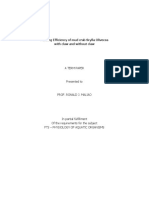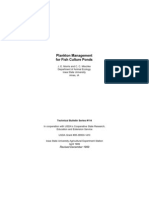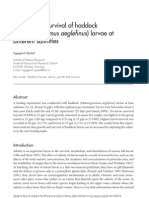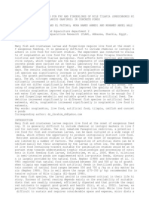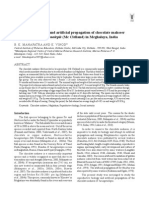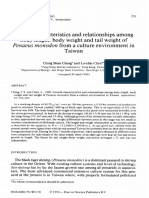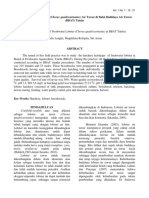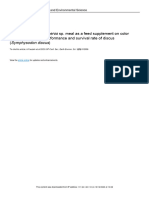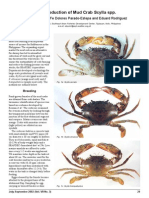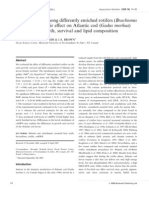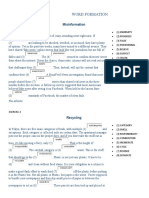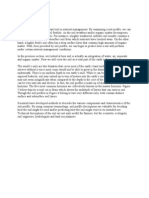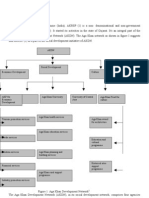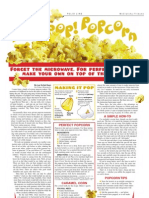Professional Documents
Culture Documents
Effect of Water Hardness On Egg Hatchability and Larval Viability of Angelfish (Pterophyllum Scalare PDF
Uploaded by
Agatya Sara AOriginal Description:
Original Title
Copyright
Available Formats
Share this document
Did you find this document useful?
Is this content inappropriate?
Report this DocumentCopyright:
Available Formats
Effect of Water Hardness On Egg Hatchability and Larval Viability of Angelfish (Pterophyllum Scalare PDF
Uploaded by
Agatya Sara ACopyright:
Available Formats
Available online at http://www.urpjournals.
com
International Journal of Research in Fisheries and Aquaculture
Universal Research Publications. All rights reserved
Original Article Effect Of Water Hardness On Egg Hatchability And Larval Viability Of Angelfish (Pterophyllum scalare (Schultze, 1823)
1
Milad Kasiri1, Mohammad Sudagar1 and Seyed Abbas Hosseini1 Department of Fishery, Gorgan University of Agricultural Sciences and Natural Resources Iran, Golestan, Gorgan, Shahid Beheshti Avenue, Postal code: 49138-15739 kasiri_milad@yahoo.com Received 28 August 2011; accepted 11 September 2011
Abstract The response to water hardness increase varies from species to species. The purpose of this study was to verify the effect of water hardness on angelfish (Pterophyllum scalare) egg hatchability and larval viability. The fertilized eggs and larvae were exposed to seven water hardness values (10, 50, 100, 150, 200, 250, and 300 mg/l CaCO3) at pH 7.25 and 28 C. Survival was calculated until day 21. The highest survival rate at the end of the experiment was (50.39 6.23%) observed at the water hardness of 100 mg/l CaCO3. The results imply that too soft water (10 mg/l CaCO3) and too hard water (300 mg/l CaCO3) are not suitable for Pterophyllum scalare incubation and larval rearing. A moderately hard water of 100200 mg/l CaCO3 is recommended for optimal normal hatching, high viability and maximum larval development of angel fish. 2011 Universal Research Publications. All rights reserved Keywords: hard water, soft water, incubation. 1 Introduction Ornamental fishes are often referred as living jewels due to their color, shape and behavior. They are quiet, generally small size, attractively colored and could be accommodated in confined spaces. Modern ornamental fish culture and breeding operations, have become vertically and horizontally intensified, necessitating a continuous supply of nutritionally balanced, cost-effective feed (1). The angelfish (Pterophyllum scalare (Schultze, 1823)), is a cichlid native to the Amazon Basin of Brazil and exported as an ornamental fish (2). This fish is one of most popular fish species among the freshwater aquarium trade industry (3). Angelfish are among the first fish purchased for beginner, As they are inexpensive and beautiful fish. They are ideal community tank fish and available in several color and forms (such as black zebra angelfish, Cobra angelfish, Half black angelfish and Koi angelfish) The past 50 years of commercial and hobby breeding of Pterophyllum scalare have produced a hardy fish tolerant of common tap water conditions, a great range of temperatures, and resistant to diseases (4). Total hardness is the concentration of all divalent cations in water, and Ca2+ and Mg2+ are the most common cations in almost all fresh water systems. Skeletal growth in vertebrates is partially controlled by the availability of minerals. The correlation between aqueous calcium content and fish skeletal growth (ossification) is especially important as calcium absorption from water is an essential route to acquire this mineral (5). The suggested value for water hardness for fish cultivation in ponds is above 20 mg/l CaCO3 (6, 7). One of the important processes during the early development of teleost egg is the swelling of newly fertilized eggs, which water hardness has been exhibited to have a direct effect on this stage (8). Abernathy (9) found that calcium and magnesium both contribute to water hardness, calcium, not magnesium, is necessary for the development and survival of rainbow sharkminnow eggs. Calcium, although necessary, was found to have a detrimental effect at higher concentrations due to its increasing the osmotic concentration of the incubation water which directly effected the swelling of the eggs, reducing larval survival. Different species of fish showed different percentage of survival at various different hardnesses. Channel catfish (Ictalurus punctatus (Rafinesque, 1818)) survival was improved when water hardness increased from 40 to 440 mg/l CaCO3 (10). Gonzal et al. (11) found that water hardness
International Journal of Research in Fisheries and Aquaculture 2011; 1(1): 6-10
Table 1: Nutriente composition of Prepared granulated feed diets (%) Diet Commercial extruder diet Protein 54 Lipid 18 Fiber 1.5 Ash 10 Vitamin 2 Table 2: Comparison mean ( SD) for Pterophyllum scalare egg hatchability and larval survival at different levels of total water hardness. Larval survival to end of yolk sac Total hardness (mg/l CaCO3) Hatchability (%) period (%) 10 64.71 5.58c 71.15 1.82c* 50 65.83 7.33bc 83.17 7.26a ab 100 73.26 4.66 85.31 5.58a abc 150 70.74 6.57 83.63 7.67a ab 200 73.57 1.61 80.73 3.48ab a 250 74.60 4.66 78.05 4.52abc bc 300 65.88 9.10 75.14 3.18bc Groups with different alphabetic superscripts differ significantly at P < 0.05. *Treatment with survivors in only two replicate in end of yolk sac period. Table 3: Survival rate (%) of Pterophyllum scalare during 21 days after yolk sac period as a function of water hardness Total hardness Day 7 Day 14 Day21 (mg/l CaCO3) ab 50 67.84 7.29 79.20 7.23 87.79 4.49 100 69.08 6.29a 81.87 1.94 88.78 4.33 150 68.82 7.09a 84.42 9.02 87.40 3.01 200 67.34 8.31ab 81.82 6.93 85.49 5.41 250 60.34 4.29bc 78.71 4.16 83.31 3.92 300 57.50 4.30c 76.59 8.18 84.21 3.96 Groups with different alphabetic superscripts differ significantly at P < 0.05. Table 4: larvae length of Pterophyllum scalare (mm) during 21 day. Total hardness Day 7 Day 14 (mg/l CaCO3) b 50 4.15 0.08 6.38 0.24ab a 100 4.38 0.17 6.45 0.06a a 150 4.30 0.16 6.43 0.13ab bc 200 4.04 0.06 6.35 0.25ab bc 250 4.02 0.14 6.33 0.17ab c 300 3.99 0.07 6.20 0.16b Groups with different alphabetic superscripts differ significantly at P < 0.05. from 100-600 mg/l CaCO3, in silver carp (Hypophthalmichthys molitrix (Valenciennes, 1844)) eggs had the greatest hatch and viability. However, another study showed higher larval growth and survival in Rhamdia quelen (Siluriformes Pimelodidae) were obtained at 30 and 70 mg/l CaCO3 and best hatching rate, high viability and maximum larval development of Clarias gariepinus (Burchell, 1822) were obtained in water with hardness of 3060 mg/l CaCO3 (12). The aim of this study, therefore, was to investigate the effect of water hardness for hatching and viability of
Day21 8.44 0.33a 8.46 0.15a 8.45 0.18a 8.40 0.12a 8.08 0.04b 7.90 0.18b
angelfish eggs. The results of this study will be useful in improving ornamental fish hatchery systems. 2 Materials and Methods Fourteen pairs of 15 months angelfish (average weight of 14.060.72 g and average length of 12.170.36 cm) were randomly stocked into each aquarium (4) with six replications per treatment. Angel fish were obtained from the Institute of Ornamental Fish Hatchery in Ghazvin, Iran and transferred to the place of experiment in Institute of Ornamental Fish Hatchery in Babol, Iran and were acclimatized for 2 weeks.
International Journal of Research in Fisheries and Aquaculture 2011; 1(1): 6-10
Figure 1: Survival from end of hatching period to day 21. Fish were fed with prepared granulated feed (table 1) until be satuated, twice per day (09:00 a.m and 17:00 p.m). Fish food granule size was 2.5 mm. The trials were conducted in 14 (803040 cm) glass aquaria. Gentle aeration was provided by air stones. After 30 days feeding, breeders were spawned during five month. After spawning the substratum containing eggs removed for mechanical hatching and fertilized eggs were incubated at 28 C at seven levels of water hardness: 10, 50, 100,150, 200, 250 and 300 mg/l CaCO3 using aerated 15 circular plastic tanks (20 cm in diameter). Methylene blue solution added to the water sufficiently to tint the water deep, dark blue (4). After hatching, the embryos were counted and the percentage determined for each water hardness. After yolk sac absorption (4 days), larvae of each treatment were maintained in continuously aerated 40 l polyethylene tanks for 21 days. Feces and other wastes were discharged every day and 50% of water was exchanged with fresh water has the desired hardness. During larval rearing, incubation remnants, dead larvae and waste were siphoned off every day to avoid any means of stress. Three developmental periods were defined: the hatching period, the yolk sac period and the growth period. The hatching period began when the first larvae was observed and ended when larvae had hatched. The yolk sac period extended from end of hatching period to the yolk-sac of the larvae was absorbed (yolk sac absorption was determined visually) (12). The growth period began from the end of yolk sac period to 21 days of the hatching. Larvae were fed with only Artemia nauplii to be satiated four times a day (08:00, 11:00 a.m and 14:00, 17:00 p.m) according to Goldestin (4). After yolk sac period, larvae were counted from all replicate on days 0, 7, 14 and 21 and samples of 20 larvae were collected from each replicate and the length were measured and noted. The percentage of eggs and larvae survival at the end of each developmental period
was determined. Data on hatchability and larval survival were included normality and variance homogeneity analysis analyzed with one-way analysis of variance (ANOVA) and Duncans Multiple Range Test (DMRT) (using SPSS 16.0 program) to test for significant differences in various water hardnesses. Significance was established at the 0.05 levels. 3 Results During the experiment, the water quality parameters were monitored during the trial and average value for temperature, dissolved oxygen, pH and salinity were 282 C, 5.8-7.5 mgl1 , 6.9-7.8 units and 0.1 mg l-1, respectively. Water hardness and pH showed minor alterations in all treatments remaining within the expected range throughout the experiments. The effects of water hardness on hatching rate and larvae survival were presented in table 2. The highest hatching rate observed at 250 mg/l CaCO3 and the lowest ones found at 10 and 50 mg/l CaCO3 (P < 0.05). There was a significant difference among experimental groups in percentage of larval survival to end of yolk sac period (P < 0.05). The best survival were observed at 50, 100 and 150 mg/l CaCO3. Furthermore, at 10 mg/l CaCO3 larvae just remained alive in two replicates to the end of yolk sac period, as well as to day 7 after this stage no larvae remained in this treatment (table 2). According to table 3 to day 7, higher larval survival (P < 0.05) were observed at 100 and 150 mg/l CaCO3 (69.08 6.29 and 68.82 7.09 (%), respectively) but in days 14 and 21, larvae survival didnt show significant difference ( P > 0.05) among experimental groups. The most larval mortality was observed in day 7 after yolk sac absorption and lower larval survival in this stage observed at water hardness of 300 mg/l CaCO3 (57.50 4.30%). The highest survival rate at the end of the experiment was recorded at the water hardness of 100 mg/l CaCO3 (50.39 6.23%) (Fig. 1). Throughout the period of 21 days, larvae maintained at water hardness of 100-200 mg/l CaCO3 showed better length than the other treatments (table 4). 4 Discussion The perivitelline space is located between the outer chorion of the egg and the vitelline membrane that surrounds the developing embryo. In a fertilized egg, the fluid filled perivitelline space provides room and protection for embryonic development (13). Ca2+ in incubation waters was ion. Thus, solute concentration (osmolality) was directly proportional to the ionic concentration (increased solute concentration = increased ionic concentration). Increasing the solute/ionic concentration of the incubation waters increased the osmotic concentration (increased solute/ionic concentration = increased osmotic concentration) (9). Hatchability in treatments, decreased in very hard and very soft water in effect of osmotic concentration. This can be explained by the fact that egg swelling is an osmoticaly driven process. When osmotic concentration is greater inside
International Journal of Research in Fisheries and Aquaculture 2011; 1(1): 6-10
the perivitelline space than the extracellular water surrounding the egg, extracellular water moves into the perivitelline space via osmosis causing the egg to swell. Typically, egg swelling increases when water hardness decreases because low water hardness usually means low osmolarity, and its swelling decrease when water hardness incrasees. The fact that, decreasing the hatchibility in very soft and very hard incubation waters mean that the CaCO3 in incubation waters were effective on angelfish eggs. In this study the highest larvae survival observed in soft water 50-100 mg/l CaCO3. It is agreed with studies results of Molokwu and Okpokwasili (12) examined the effects of increasing water hardness on hatch rates and larvae survival of Clarias gariepinus. They found that increasing in water hardness reduced larval survival. Also Abernathy (9) found that very soft waters (6.4-7.0 mg/l as CaCO3) produced the highest hatch and larval survival of rainbow sharkminnow (Epalzeorhynchos frenatum), In our study the best hatchability was found at 250 mg/l CaCO3 (74.60 4.64 %). Wild angelfish need to soft and acidic water but domestic angelfish dont need to this conditions. Many fish found under restrictive conditions in nature live better and easier when presented with entirely different conditions in captivity. The habitat conditions in nature may not indicate the fish's requirements, but rather its tolerance of conditions not tolerated by its competitors and predators (4). So, soft and acidic water is not a necessary condition for domestic angelfishes. The apparent survival of angel fish larvae was lower (57.50 4.30%) in the day 7 of the experiment at higher water hardness. This mortality may be related to the osmotic stress induced by water hardness, which also reduced length (3.99 0.07mm) of angel fish larvae. This difference in tolerance to high water hardness levels may be age-related, since the ability to maintain Ca 2+ homeostasis improves with development (14). Recently hatched larvae have gills and renal complexes not fully developed, but maintain their internal concentration with chloride cells located on the skin (15). Twenty-six days after hatching, rainbow trout larvae presented 75% of all chloride cells in the gills. As chloride cells in the gills are more efficient in terms of ion exchange than those on the skin (15), the ionoregulatory capacity of larvae at next two week would be improved in relation to larvae, explaining their higher survival in water with high hardness levels. Townsend et al. (16) showed that the highest survival rate and growth of Rhamdia quelen (Siluriformes Pimelodidae) were obtained at the low water hardness (30 and 70 mg/l CaCO3), but in this study the highest survival rate was found at the 100 mg/l CaCO3 and growth rate obtained at 50 to 200 mg/l CaCO3 was higher. Morgan et al. (17) found that an increase in water hardness reduced or eliminated the effect of silver toxicity in early life
stages of rainbow trout (Oncorhynchus mykiss), while enhancing fish survival. However in our study the highest survival rate was found at moderately hard water (100 mg/l CaCO3). In this study we found the highest survival rate in 100 mg/l CaCO3 , but Blanksma et al. (2009) studied the effects of water hardness on skeletal development and growth in juvenile fathead minnows, and pointed that fathead minnows reared in calcium-abundant water (Ca = 65 1.5 mg/l as CaCO3; hardness 175 mg/l) had significantly increased survival but lower whole body mass when compared to their conspecifics in lowcalcium water. These results imply that hardness affects on water conditions for use in Pterophyllum scalare hatcheries and too soft water (010 mg/l) and too hard water (300 mg/l) are not suitable for Pterophyllum scalare egg incubation and larval rearing. References 1. B. Mandal, A. Mukherjee and S. Banerjee, Growth and pigmentation development efficiencies in fantail guppy, Poecilia reticulata fed with commercially available feeds. Agricult. Biol. J. North. America. (2010), 1(6): 1264-1267. 2. M.D.S. Cacho, S. Chellappa and M.E. Yamamoto, Reproductive success and female preference in the amazonian cichlid angel fish, Pterophyllum scalare. Neotropic. Ichth. (2006), 4:87-91. 3. M. Garcia-Ulloa, and H.J. Gomez-Romero, Growth of angel fish Pterophyllum scalare juveniles fed inert diets. Avanc. en Invest. Agrop. (2005), 9(3): 49-60. 4. R.J. Goldstein, Angelfish a complete pet owner's manual. Barron's Educational Series, New York (2001), 81 pp. 5. C. Blanksma, , B. Eguia, k. Lott., J.M. Lazorchak., M.E. Smith., M. Wratschko., T.D. Dawson., C. Elonen., M. Kahl and H.L. Schoenfuss, Effects of water hardness on skeletal development and growth in juvenile fathead minnows. Aquaculture (2009), 286: 226232. 6. C.E. Boyd,. Water quality for pond aquaculture. Research and Development Series (Alabama) 43 (1998), Auguest, 37 pp. 7. R.D. Zweig, J.D. Morton and M.M. Stewart, Source Water Quality for Aquaculture. World Bank, Washington (1999), 62 pp. 8. Spade, S. and B. Bristow, Effects of increasing water hardness on egg diameter and hatch rates of striped bass eggs. Nor. Americ. J. Aquacul. (1999), 61:263-265. 9. M.A. Abernathy, Effect of water hardness on the survival of rainbow sharkminnow (Epalzeorhynchos frenatum) eggs and larvae. MSc Thesis, University of Florida, Florida (2004), 63pp. 10. J.R. Tomasso, C.A. Goudie., B.A. Simco and K.B. Davis, Effects of environmental pH and calcium on
International Journal of Research in Fisheries and Aquaculture 2011; 1(1): 6-10
11.
12. 13.
14.
ammonia toxicity in channel catfish. Tran. Americ. Fisher. Soc. (1980), 109:229234. A.C. Gonzal, E.V. Aralar, and J. M. F. Pavico, The effects of water hardness on the hatching and viability of silver carp (Hypophthalmichthys molitrix) eggs. Aquaculture (1987), 64:111-118. C.N Molokwu, and G.C. Okpokwasili, Effect of water hardness on egg hatchability and larval viability of Clarias gariepinus. Aquac. Int. (2002), 10:5764. F. B. Eddy, Osmotic properties of the perivitelline fluid and some properties of the chorion of Atlantic salmon eggs (Salmo salar). J. Zool, London. (1974), 174: 237243. J.M. Grizzle and A.C. Mauldin, Age-related changes in survival of larval and juvenile striped bass in different
concentrations of calcium and sodium. Trans. Americ. Fisher. Soc. (1994), 123: 10021005. 15. P.J. Rombough, The gill of fish larvae. Is it primarily a respiratory or an ionoregulation structure? J. Fish Biol. (1999), 55: 186204. 16. C.R. Townsend, L.V.F. Silva and B. Baldisserotto, Growth and survival of Rhamdia quelen (Siluriformes Pimelodidae) larvae exposed to different levels of water hardness. Aquacult. (2003), 215:103108. 17. T.P. Morgan, C.M. Guadagnolo, M. Grosell and M. Wood, Effects of water hardness on the physiological responses to chronic waterborne silver exposure in early life stages of rainbow trout (Oncorhynchus mykiss). Aqua. Toxic. (2005), 74 : 333350.
Source of support: Nil; Conflict of interest: None declared
10
International Journal of Research in Fisheries and Aquaculture 2011; 1(1): 6-10
You might also like
- Short Communication Article Suitability of Water Salinity For Hatching and Survival of Newly Hatched Larvae of Climbing Perch, Anabas TestudineusDocument14 pagesShort Communication Article Suitability of Water Salinity For Hatching and Survival of Newly Hatched Larvae of Climbing Perch, Anabas TestudineusHassan AL-HilallyNo ratings yet
- Survival and Growth of Macrobrachium Rosenbergii (De Man) Juvenile in Relation To Calcium Hardness and Bicarbonate AlkalinityDocument4 pagesSurvival and Growth of Macrobrachium Rosenbergii (De Man) Juvenile in Relation To Calcium Hardness and Bicarbonate AlkalinityCiro PerlaNo ratings yet
- Josileen Jose - 2023 - Crab Culture - Course Manual Winter School On Mariculture TechnologiesDocument12 pagesJosileen Jose - 2023 - Crab Culture - Course Manual Winter School On Mariculture TechnologiesTriana DewiNo ratings yet
- (404 411) V9N7CTDocument8 pages(404 411) V9N7CTRusmin NuryadinNo ratings yet
- 60-Article Text-43-1-10-20190513Document10 pages60-Article Text-43-1-10-20190513Sandy Wahyu DNo ratings yet
- Rapid Variation in Kidney Histology in Spotted Scat: Scatophagus Argus On Exposed To Abrupt Salinity ChangesDocument6 pagesRapid Variation in Kidney Histology in Spotted Scat: Scatophagus Argus On Exposed To Abrupt Salinity ChangesBadzlina Aditya SudrajadNo ratings yet
- Integration of Intensive and Semi-Intensive AquacultureDocument7 pagesIntegration of Intensive and Semi-Intensive AquacultureAlee Di VaioNo ratings yet
- Arish University Faculty of Aquaculture and Marine Fisheries North Sinai, EgyptDocument7 pagesArish University Faculty of Aquaculture and Marine Fisheries North Sinai, Egyptesraa 3mmarNo ratings yet
- Feeding Efficiency of Mud Crab Scylla Olivecea With Claw and Without ClawDocument17 pagesFeeding Efficiency of Mud Crab Scylla Olivecea With Claw and Without ClawMaedelyn Barrios GonzalesNo ratings yet
- Captive Breeding of Devario PathiranaDocument7 pagesCaptive Breeding of Devario Pathirana-Madusha Umayanga-No ratings yet
- Alternative Supplementary Biochemic Food For Growing Up The Fresh Water Lobster (Cherax Quadricarinatus)Document8 pagesAlternative Supplementary Biochemic Food For Growing Up The Fresh Water Lobster (Cherax Quadricarinatus)Biodiversitas, etcNo ratings yet
- Biological Controls To Manage Flatworms in Coral AquacultureDocument6 pagesBiological Controls To Manage Flatworms in Coral Aquacultureluiggi zambranoNo ratings yet
- 19290-Article Text-58851-2-10-20180315Document12 pages19290-Article Text-58851-2-10-20180315NUR AININo ratings yet
- Bartonetal 2020BiocontrolofAEFWDocument7 pagesBartonetal 2020BiocontrolofAEFWpawanhv1454No ratings yet
- Document 1Document54 pagesDocument 1narayanasamy30No ratings yet
- The Mass Seed Production of Golden Trevally Fish (Gnathanodon Speciosus Forsskal) WITH DIFFERENT FEEDDocument8 pagesThe Mass Seed Production of Golden Trevally Fish (Gnathanodon Speciosus Forsskal) WITH DIFFERENT FEEDIhsan FauzanNo ratings yet
- EIRAS Et Al Effect of Artificial Sea Water and Feeding Frequency On The Larval Culture of Freshwater Amazonian Ornamental Fish Banded Cichlid Heros SeveruDocument8 pagesEIRAS Et Al Effect of Artificial Sea Water and Feeding Frequency On The Larval Culture of Freshwater Amazonian Ornamental Fish Banded Cichlid Heros SeveruBruno EirasNo ratings yet
- Plankton Management For Fish Culture Ponds: Technical Bulletin Series #114Document8 pagesPlankton Management For Fish Culture Ponds: Technical Bulletin Series #114MiwisaAyu DevianiNo ratings yet
- BIOL 111L YB Ex. 5 Group 2 PDFDocument24 pagesBIOL 111L YB Ex. 5 Group 2 PDFKimNo ratings yet
- 18607-Article Text-66749-2-10-20180629Document8 pages18607-Article Text-66749-2-10-20180629Aldo OtangNo ratings yet
- Betta Slan 7 PDFDocument8 pagesBetta Slan 7 PDFRomy ArdianNo ratings yet
- Polyculture of Pacific White Shrimp Litopenaeus Vannamei Giant 1Document6 pagesPolyculture of Pacific White Shrimp Litopenaeus Vannamei Giant 1SteveTillalsoNo ratings yet
- Ops TadDocument7 pagesOps TadJeff GoNo ratings yet
- LIM Et Al 2003 Desenvolvimentos Recentes Na Aplicação de Alimentos Vivos Na Piscicultura de Água Doce OrnamentalDocument13 pagesLIM Et Al 2003 Desenvolvimentos Recentes Na Aplicação de Alimentos Vivos Na Piscicultura de Água Doce OrnamentalDaniel CostaNo ratings yet
- Supplied Fish Larvae As Feed in Larval Rearing of Yellowfin Tuna Thunnus Albacares AT DIFFERENT AGEDocument12 pagesSupplied Fish Larvae As Feed in Larval Rearing of Yellowfin Tuna Thunnus Albacares AT DIFFERENT AGEzara adistiNo ratings yet
- Scientific Note Breeding and Seed Production of Green Back MulletDocument4 pagesScientific Note Breeding and Seed Production of Green Back MulletboonyongchiraNo ratings yet
- IOSR JournalsDocument3 pagesIOSR JournalsInternational Organization of Scientific Research (IOSR)No ratings yet
- Zooplankton As Live Food For Fry and Fingerlings of NileDocument14 pagesZooplankton As Live Food For Fry and Fingerlings of NilethehealingartistNo ratings yet
- Penetasan Telur, Pemeliharaan Larva, Dan Biologi REPRODUKSI CUMI-CUMI, Sepioteuthis Lessoniana LESSONDocument12 pagesPenetasan Telur, Pemeliharaan Larva, Dan Biologi REPRODUKSI CUMI-CUMI, Sepioteuthis Lessoniana LESSONJufrensis Pranata SembiringNo ratings yet
- Growth Performance of Angelfish PterophyDocument7 pagesGrowth Performance of Angelfish PterophyArdian RahmanNo ratings yet
- 5 Zooplankton PDFDocument15 pages5 Zooplankton PDFAkhiro EddyNo ratings yet
- Aureus) On Fish Growth, Water Quality and TomatoDocument6 pagesAureus) On Fish Growth, Water Quality and TomatoIJEAB JournalNo ratings yet
- A - 3A101681362312220210505 497 7mcd8g With Cover Page v2Document13 pagesA - 3A101681362312220210505 497 7mcd8g With Cover Page v2Michaiel PiticarNo ratings yet
- Reproductive Biology and Artificial Propagation of Chocolate Mahseer Neolissocheilus Hexagonolepis (MC Clelland) in Meghalaya, IndiaDocument6 pagesReproductive Biology and Artificial Propagation of Chocolate Mahseer Neolissocheilus Hexagonolepis (MC Clelland) in Meghalaya, IndiaDR. BIJAY KALI MAHAPATRANo ratings yet
- Optimal Salinity and Temperature For Early Developmental Stages of Penaeus Merguiensis de ManDocument10 pagesOptimal Salinity and Temperature For Early Developmental Stages of Penaeus Merguiensis de ManOttoman CavalierNo ratings yet
- Perbedaan Waktu Pemeliharaan Telur Dan Larva Oleh Induk Jantan Terhadap Daya Tetas Dan Kelangsungan Hidup Larva Ikan Cupang (Betta Splendens)Document6 pagesPerbedaan Waktu Pemeliharaan Telur Dan Larva Oleh Induk Jantan Terhadap Daya Tetas Dan Kelangsungan Hidup Larva Ikan Cupang (Betta Splendens)MujionoNo ratings yet
- Aquaponics Systems, Fish. Volume 6: Sistemas de acuaponíaFrom EverandAquaponics Systems, Fish. Volume 6: Sistemas de acuaponíaNo ratings yet
- Growth Performance and Survival Rate of Striped Eel CatfishDocument10 pagesGrowth Performance and Survival Rate of Striped Eel CatfishZay YanaNo ratings yet
- Pendederan Larva Ikan Gabus (Channa Striata) Di Kolam Terpal Dengan Padat Tebar BerbedaDocument10 pagesPendederan Larva Ikan Gabus (Channa Striata) Di Kolam Terpal Dengan Padat Tebar BerbedaMuslim MuslimNo ratings yet
- Cheng 1990Document11 pagesCheng 1990yaumilakbarNo ratings yet
- Saline Preferendum For The European Sea Bass, Dicentrarchus Labrax, Larvae and Juveniles Effect of Salinity On Early Development and Sex DeterminationDocument15 pagesSaline Preferendum For The European Sea Bass, Dicentrarchus Labrax, Larvae and Juveniles Effect of Salinity On Early Development and Sex Determinationmuratout3447No ratings yet
- Effects of Water Flow Rates On Growth and Welfare of Nile Tilapia (Oreochromis Niloticus) Reared in A Recirculating Aquaculture SystemDocument14 pagesEffects of Water Flow Rates On Growth and Welfare of Nile Tilapia (Oreochromis Niloticus) Reared in A Recirculating Aquaculture SystemSuhardi AtmokoNo ratings yet
- Aquaculture Reports: Matthew Wassnig, Paul C. SouthgateDocument5 pagesAquaculture Reports: Matthew Wassnig, Paul C. SouthgateRaka Putra NugrahaNo ratings yet
- Teknik Budidaya Lobster (Cherax Quadricarinatus) Air Tawar Di Balai Budidaya Air Tawar (BBAT) TateluDocument7 pagesTeknik Budidaya Lobster (Cherax Quadricarinatus) Air Tawar Di Balai Budidaya Air Tawar (BBAT) TatelusiswoutNo ratings yet
- Effects of Fish Size and Biofiltration Techniques On Water Quality and Nitrogen Removal Efficiency in Recirculating Aquaculture SystemsDocument11 pagesEffects of Fish Size and Biofiltration Techniques On Water Quality and Nitrogen Removal Efficiency in Recirculating Aquaculture Systemsrahma apriantyNo ratings yet
- AchotinesTunaCulturePaper 2003Document27 pagesAchotinesTunaCulturePaper 2003faisalsbyNo ratings yet
- Fire Shrimp BreedingDocument4 pagesFire Shrimp BreedingKostadin IvanovNo ratings yet
- Jurnal Mina Sains ISSN: 2407-9030 Volume 2 Nomor 1, April 2016 24Document7 pagesJurnal Mina Sains ISSN: 2407-9030 Volume 2 Nomor 1, April 2016 24Aji FirdausNo ratings yet
- Incofims 2023Document7 pagesIncofims 2023atikamarisaNo ratings yet
- 7IJEAB NOV 2017 5 RoleofstockingdensityoftilapiaDocument7 pages7IJEAB NOV 2017 5 RoleofstockingdensityoftilapiaAzteca 26No ratings yet
- Seed Production MudcrabDocument3 pagesSeed Production MudcrabCharles Figueroa100% (1)
- The Effect of Temperature On The Hatching Success of Brine ShrimpsDocument15 pagesThe Effect of Temperature On The Hatching Success of Brine ShrimpsTootsie82% (11)
- Olesen 1983 Aquacultural-EngineeringDocument12 pagesOlesen 1983 Aquacultural-EngineeringJorge RodriguezNo ratings yet
- A Comparative Study of Egg and Sperm QuaDocument10 pagesA Comparative Study of Egg and Sperm QuaWahyu PamungkasNo ratings yet
- Recirculation Air System (RAS)Document9 pagesRecirculation Air System (RAS)Luq ManNo ratings yet
- Alimentacion LarvalDocument5 pagesAlimentacion LarvalUlises CeliNo ratings yet
- Asdsadsada RoleofstockingdensityoftilapiaDocument7 pagesAsdsadsada RoleofstockingdensityoftilapiaSebastian Prasetyo BudiNo ratings yet
- Effect of Different Photoperiod Regimes On Sperm Quality, Fecundity and Fertilization in Rainbow Trout (Oncorhynchus Mykiss)Document7 pagesEffect of Different Photoperiod Regimes On Sperm Quality, Fecundity and Fertilization in Rainbow Trout (Oncorhynchus Mykiss)Hanggo PambudiNo ratings yet
- A Comparison Among Differently Enriched Rotifers (Brachionus Plicatilis) and Their Effect On Atlantic Cod (Gadus Morhua) Larvae Early Growth, Survival and Lipid CompositionDocument17 pagesA Comparison Among Differently Enriched Rotifers (Brachionus Plicatilis) and Their Effect On Atlantic Cod (Gadus Morhua) Larvae Early Growth, Survival and Lipid CompositionAgatya Sara ANo ratings yet
- Acoustical Monitoring of Fish Density, Behavior, and Growth Rate in A TankDocument10 pagesAcoustical Monitoring of Fish Density, Behavior, and Growth Rate in A TankAgatya Sara ANo ratings yet
- A Bioeconomic Evaluation of A Commercial Scale Recirculating Finfish Growout System - An Australian PerspectiveDocument13 pagesA Bioeconomic Evaluation of A Commercial Scale Recirculating Finfish Growout System - An Australian PerspectiveAgatya Sara ANo ratings yet
- A Conceptual, Stoichiometry-Based Model For Single-Sludge Denitrification in Recirculating Aquaculture SystemsDocument14 pagesA Conceptual, Stoichiometry-Based Model For Single-Sludge Denitrification in Recirculating Aquaculture SystemsAgatya Sara ANo ratings yet
- Incubation of Silver Catfish, Rhamdia Quelen (Pimelodidae), Eggs at Different Calcium and Magnesium ConcentrationsDocument9 pagesIncubation of Silver Catfish, Rhamdia Quelen (Pimelodidae), Eggs at Different Calcium and Magnesium ConcentrationsAgatya Sara ANo ratings yet
- Aquaculture Development and The Fisheries Act 1994Document10 pagesAquaculture Development and The Fisheries Act 1994Agatya Sara ANo ratings yet
- Reproduction in Three Species of RainbowfishDocument13 pagesReproduction in Three Species of RainbowfishAgatya Sara ANo ratings yet
- Growth and Survival of Rhamdia Quelen (Siluriformes, Pimelodidae) Larvae Exposed To Different Levels of Water HardnessDocument6 pagesGrowth and Survival of Rhamdia Quelen (Siluriformes, Pimelodidae) Larvae Exposed To Different Levels of Water HardnessAgatya Sara ANo ratings yet
- Growth and Survival of Rhamdia Quelen (Siluriformes, Pimelodidae) Larvae Exposed To Different Levels of Water HardnessDocument6 pagesGrowth and Survival of Rhamdia Quelen (Siluriformes, Pimelodidae) Larvae Exposed To Different Levels of Water HardnessAgatya Sara ANo ratings yet
- Acme Juicer ManualDocument12 pagesAcme Juicer Manualmilesdzyn100% (1)
- Greenhouse Humidity Control SolutionDocument25 pagesGreenhouse Humidity Control SolutionArthur GostickNo ratings yet
- Unit of Competency: Raise Organic Chicken Module Title: Raising Organic Chicken Module DescriptionDocument59 pagesUnit of Competency: Raise Organic Chicken Module Title: Raising Organic Chicken Module DescriptionMarjurie Tan Ang100% (2)
- Wheat FlourDocument12 pagesWheat Flourbig johnNo ratings yet
- BrochureDocument4 pagesBrochurevishva shahNo ratings yet
- Word Formation CpeDocument12 pagesWord Formation CpeNgọc Minh0% (1)
- Davis Thinking Like A ChickenDocument12 pagesDavis Thinking Like A Chickennataliek88No ratings yet
- Selected Research Issues in The Malaysian Agricultural SectorDocument10 pagesSelected Research Issues in The Malaysian Agricultural SectorNur HazwaniNo ratings yet
- The Introduction of Low-Cost Polyethylene Tube DigDocument21 pagesThe Introduction of Low-Cost Polyethylene Tube DigDennis KasaboNo ratings yet
- Impact On The Zeolite Usage in Diary Cows Nutrition To Their Health Characteristics - Z. Ilić, S. Pešev, M. Milenković, B. MiloševićDocument9 pagesImpact On The Zeolite Usage in Diary Cows Nutrition To Their Health Characteristics - Z. Ilić, S. Pešev, M. Milenković, B. MiloševićCk_psihNo ratings yet
- Calcium HandoutDocument2 pagesCalcium Handoutapi-283249978No ratings yet
- Soil ProfileDocument4 pagesSoil ProfileHidayah DungunNo ratings yet
- REVIEWERDocument5 pagesREVIEWERKirsten Elry AlcantaraNo ratings yet
- Soil WorksheetDocument19 pagesSoil WorksheetdhwaniNo ratings yet
- Craig House Brochure TextDocument8 pagesCraig House Brochure Textmharper418No ratings yet
- Information About Saffron CultivationDocument5 pagesInformation About Saffron Cultivationthakurpushplata9No ratings yet
- Solved Paper SSC Combined Graduate Level Prelim Exam Held On 16.05.2010 First SittingDocument21 pagesSolved Paper SSC Combined Graduate Level Prelim Exam Held On 16.05.2010 First SittingNaren N End NNo ratings yet
- Caso GuajiloteDocument8 pagesCaso GuajiloteChucho GuadarramaNo ratings yet
- Theory of Agri-Tourism and Its PracticeDocument10 pagesTheory of Agri-Tourism and Its PracticeZejkeara ImperialNo ratings yet
- Organic Farming Success StoryDocument2 pagesOrganic Farming Success StoryCloverorganicNo ratings yet
- CATALOG VANE TALIS Your Partner For Water and Sewage en 02 2012Document36 pagesCATALOG VANE TALIS Your Partner For Water and Sewage en 02 2012Dragne HoratiuNo ratings yet
- Chili Proliga - IOPDocument14 pagesChili Proliga - IOPGigi BiazNo ratings yet
- Project On Botanical ExtractDocument11 pagesProject On Botanical Extractmogreshikha73No ratings yet
- Ou Akrsp 25025-25 OurevisiDocument32 pagesOu Akrsp 25025-25 Ourevisiapi-3774915100% (2)
- Env - Law - Forest ACtDocument6 pagesEnv - Law - Forest ACtMayank SharmaNo ratings yet
- Shrub - Wikipedia, The Free EncyclopediaDocument5 pagesShrub - Wikipedia, The Free EncyclopediabmxengineeringNo ratings yet
- Marketing Channel TomatoDocument58 pagesMarketing Channel TomatoShie Castillo ChuacoNo ratings yet
- Pop! Pop! Popcorn!Document1 pagePop! Pop! Popcorn!The State Newspaper100% (3)
- by MeenaDocument18 pagesby MeenaMeena SinghNo ratings yet








